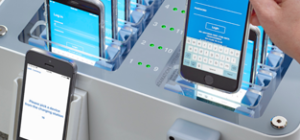Many clinicians spend a significant amount of time in the EHR, as it’s a critical tool for coordinating patient care. Providers and other clinical colleagues maintain the patient chart and take detailed notes in order to paint a comprehensive picture of the patient’s history, condition and care plan.
However, many EHRs are largely accessed by desktop or laptop computers, which hinder clinicians’ mobility as they move from room to room, or even unit to unit. Fortunately, more widespread smartphone use throughout the hospital provides an opportunity for healthcare organizations to maximize their investment in the EHR and extend these mission-critical capabilities to the point of care.
Scaling the EHR’s utility to smartphones allows users to move more efficiently through the hospital, quickly make changes to the patient’s care plan, instantly contact care team members and reduce the physical and cognitive burden on clinicians, which can mitigate burnout and fatigue. In particular, clinical smartphone applications with a collaborative focus are the most impactful when it comes to extending the EHR. In this blog, we will review the optimal qualities of clinical mobile platforms in order to make the most of your organization’s EHR investment.
Mobilize the Electronic Health Record
There are plenty of clinical communication applications in the healthcare technology market, but the key to extending your EHR is leveraging a communication solution that prioritizes interoperability and key integrations. Beyond other important capabilities, such as sending nurse call alerts and critical lab values to clinicians’ smartphones, EHR integrations with mobile devices like smartphones can expand the reach of your organization’s infrastructure.
Many EHR integrations function by providing third-party vendor access to patient data via HL7, allowing access to the patient record. The vendor will work with the EHR to facilitate a connection that transmits desired information from one system to another. Depending on the purpose of the integration, this data can include basic patient details (name, bed number, vitals), care team assignments, lab values and more.
Fostering Collaboration Within the EHR
In practice, integrating your organization’s EHR with your clinical communication system serves to promote care team collaboration by making dynamic data more accessible to users. At Mobile Heartbeat, we believe that critical information should be available to care team members in real-time, and we have specific integrations to support and enable that vision.
For instance, our Dynamic Care Team capability pulls real-time care team information so that clinicians never have to wonder who else is caring for a particular patient. The entire up-to-date team is displayed under the appropriate patient—even including specialists and clinicians from ancillary departments. We pull this data from the EHR, so as staff assignments are indicated within the EHR, they are reflected instantly under Dynamic Care Team.
Similarly, any critical lab values that are displayed in the EHR can be pulled by MH-CURE and sent as an alert to the patient’s care team.
Innovating Interoperability
At the forefront of this integration technology is an opportunity to make care team collaboration easier for clinicians. The ability to launch communication capabilities, such as calling, from directly within the EHR enhances care coordination by connecting clinicians quicker and easier than ever. This integration, on the user end, is totally seamless to make the calling process as smooth and simple as possible.
Every healthcare organization has unique workflows, therefore healthcare organizations need a flexible collaborative platform that can be tailored to accommodate and support specific operations across different teams, units and facilities. Our InterApp Launch Points® API offers completely customizable links between the platform and other mission-critical tools, including the EHR, so that clinicians can move seamlessly between applications.
Configuration Support and Solutions
Each healthcare organization’s infrastructure is different, so the configuration of these integrations should reflect the specific environment and objectives of the facility. Our dedicated team of solutions engineers and support specialists has optimized the process of configuring these integrations, easing the burden on hospital IT staff.
After you’ve decided which integrations you’d like built out, our engineers will audit your infrastructure, ask questions designed to get specific and relevant information and build out the integration based on your organization’s unique requirements. This white-glove service ensures your integrations are reliable right from the start.
Because the EHR is central to hospital operations, the way to true interoperability is through purpose-built EHR integrations that advance care and promote team collaboration. With high-quality technology and a team of experts to configure critical integrations, your organization can leverage existing EHR infrastructure to truly extend the reach of the care team.
For more information on high-impact integrations with mission-critical tools, contact one of our clinical mobility specialists.





